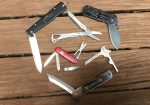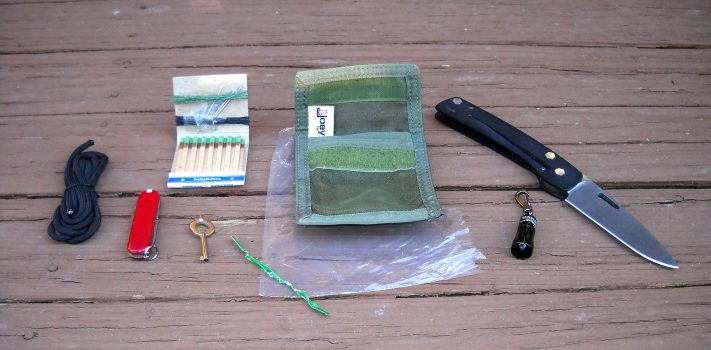In Jules Verne’s 1874 novel, The Mysterious Island, a group of Union men escape from a Confederate prison during the U.S. Civil War, in an observation balloon. They are swept away into a massive storm and survive a crash landing on a Pacific island with nothing but what they are wearing and what’s in their pockets. In an early scene, the castaways have gathered food, firewood and tinder, but the character preparing the fire suddenly discovers that he has lost his waterproof match container. A frantic search among the castaways uncovers a single match in one character’s vest, and this lone match starts their first fire on the island. Later, they learn other firemaking methods, but that first fire is critical to their survival.
The challenge facing the castaways in Verne’s book started me thinking about how I would fare if faced with a survival situation with only the things on my person. Could I start a fire, illuminate my surroundings, and perform other basic tasks? What tools would I choose for a very small kit that I could carry with me every day and in almost every location? I set about designing a micro survival kit.
The purpose of this kit is for the individual to have a few essential tools in a kit that is small enough that it will be carried every day. The trick is deciding which tools are essential and finding examples that combine high quality, small size, and lightweight. Another factor is cost: the kit should be inexpensive enough that similar kits can be made for friends or family members. We also need to find a carry system that allows the kit to be carried easily — so easily that it won’t be left behind.
You may never be in the middle of a major disaster, but car accidents, power outages, severe weather, vehicle breakdowns, and other emergencies may place you in a position to save yourself, and others, if you have the tools to do so. This article is intended to start you thinking about a very small survival kit that you could have with you on a daily basis.
The Four Basic Tools
I chose four of the most basic tools, which humans have been using for thousand of years: a knife, firemaking tools, a light, and cordage. My tools may be smaller and lighter than what ancient men used, but the need for these tools remains the same, especially when trying to survive — or help others — in an emergency.
The items in the kit described here may be backups for tools already carried by some readers, so you may wish to select a different item or make sure the tool you choose fulfills a different role. For example, if you carry a pocket knife with a single, locking blade, you might select a knife that brings a different set of tools, such as a tiny Swiss Army knife or even a very small multitool.
Everyone who tries making a tiny EDC tool kit is encouraged to start with the four basics and branch out from there. You may foresee different needs, due to your own situation and skill set. The main purpose of this article is to try to encourage people to expand the tools they carry daily, to include a few compact, useful items that may greatly enhance their ability to handle emergency situations.
Organizing the Kit
My micro survival kit was designed around a small nylon pouch with a flap that closes with Velcro. The pouch hangs on a piece of paracord. It’s nothing special, and similar pouches can easily be found, or you could make your own. If you carry your kit in a pocket, you may decide to use a small metal box, like an Altoids tin, or something similar. Though a bit larger than the pouch, a small tin container has more room, and it protects the items inside.
Alternatively, you could distribute the items on your person in pockets. My reason for putting everything together is to make it easier to grab the kit and throw it on, and to make it harder to forget something.
Such a pouch could be carried in various ways: the most basic carry is in a pocket, or it could hang from your neck, inside your shirt. Alternatively, you might consider using a longer piece of paracord, to hang the pouch under one arm. This is a more discreet way to carry, especially for men. It also reduces concern that the cord will hang up on something and choke you, and it has the additional benefit of using a longer length of paracord, which will be available when needed.
Another method is to use a short piece of paracord to loop around a belt loop or belt. The pouch then hangs inside the trousers. I’ve used a thin, nylon cord in the past to attach the pouch to a belt loop for the discreet carry of an ID, cash, and credit card(s) while travelling.
Although the pouch can be carried off-body, in a purse, backpack, etc., this brings with it the risk that you might be separated from your kit when you need it most. A better method is to make sure your kit is small enough to carry on your person.
Work out a carry system that fits your clothing and lifestyle. The important thing is to make a serious effort to have your items with you when they’re needed.
Component Details
Let’s look at each of the four tools in depth: including the largest and smallest versions I considered, as well as what I chose and why. Later, we’ll discuss some other items that could be considered for addition to your kit.
Tool #1: Knife
“It was a narrow X-acto blade, size number eleven, made of surgical quality stainless steel. The blade was an inch and a half of trouble with a thousand uses, heat-laminated inside plastic ID card stock, trimmed for just a little overlap.”
– From the novel Castigo Cay, by Matthew Bracken
 A knife or other cutting instrument is one of humankind’s oldest tools of all. It’s also one of the most versatile: capable of performing a variety of tasks, but it’s worthless if it isn’t with you when it’s needed. At a critical moment in Matt Bracken’s excellent novel, Castigo Cay, a lot depends on a tiny knife. There are some superb small cutting tools available to you today, at very good prices. What follows is a very incomplete list, but suffice to say that there’s a knife or other tool to suit almost every need.
A knife or other cutting instrument is one of humankind’s oldest tools of all. It’s also one of the most versatile: capable of performing a variety of tasks, but it’s worthless if it isn’t with you when it’s needed. At a critical moment in Matt Bracken’s excellent novel, Castigo Cay, a lot depends on a tiny knife. There are some superb small cutting tools available to you today, at very good prices. What follows is a very incomplete list, but suffice to say that there’s a knife or other tool to suit almost every need.
- Largest considered: Mercator K55K “Black Cat” Knife
- Smallest considered: X-Acto #11 Blade
- Final choice: Victorinox Classic Swiss Army Knife
- Honorable mentions: Japanese Higonokami, Swiss+Tech ST66676 Utility Key, Leatherman Style CS
Mercator K55K – Made in Solingen, Germany by Mercator and available in stainless or in carbon steel, this ultra-thin lockback has a blade length of 3.5 inches. The folded steel handle is just 0.25 inches in thickness, not counting rivets, and 4.3 inches in length when closed. It features a very good lock, and is a sturdy little knife in spite of its slim profile. It weighs just 2.7 ounces. A new version of this knife is now available with a pocket clip.
Victorinox Classic – This is the smallest Swiss Army knife that is readily available and easy to find. It offers a small main blade, scissors, a nail file with screwdriver tip, a toothpick, tweezers, and a ring for a lanyard. Its length is 2.3 inches closed and about 0.35 inches thick. It weighs 0.7 ounces. This is my recommended choice, because of its small size and because the tools add a lot of capabilities. For the record, I usually carry a smallish pocket fixed blade, or a heavy-duty folder, like the Falcon framelock, by John Greco. Therefore, the little Classic gives me a thin blade for fine tasks, plus some very useful tools.
For example, the tiny tweezers that are included with the Victorinox Classic can open locked handcuffs, as I have demonstrated to friends. I open up the tweezers like a wishbone (destroying them in the process) and use one half as a shim. Most handcuffs have “teeth” on the part that closes. The teeth engage a spring-loaded pawl inside the lock. I slide the tweezer half between the teeth and the pawl and open the cuffs. This only works if the cuffs are not “double-locked.”
Swiss+Tech Utility Key – One of the tiniest “multitools” available, this little gem combines a knife blade, bottle opener, and screwdrivers into a very small tool that weighs only 0.4 ounces. The Utility Key, when closed, is the size and shape of a key and can lock onto a key ring.
Higonokami – A Japanese “friction folder,” some of these knives are small enough for our purposes. They consist of three pieces: a blade, a handle made of folded sheet metal, and a rivet that serves as the pivot point. A small extension of the blade sticks out the end of the knife when it is closed and acts as an opening lever. When fully open, the extension lays along the handle and the pressure of your hand helps to keep the blade open They can be found online, from various sellers. Quality ranges from good to excellent. While not as versatile — nor as small — as the Victorinox Classic, my higonokami is a sturdy and very useful little folding knife that does not look threatening to the average person. My knife is 4.25 inches in length with a 2.9-inch blade and weighs 1.4 ounces.
X-Acto #11 knife blade – One of the tiniest knives you can find is an X-Acto blade. These are very small and very sharp. Mine is 1.6 inches in length and is too light for my digital scale to read! These blades must be used with great caution, and you will need to improvise a sheath from plastic, metal or some other material. If space and weight are at a premium, the X-Acto blade may work for you. I tape one inside a book of matches, but it could also be duct taped to the side of a lighter, or behind a Western-style belt buckle. Alternatives in the same style include single-edged razor blades, or the blades used in sliding utility knives.
Leatherman Style CS – Like some of the other tiny Leatherman tools, the Style CS unfolds to deploy a very good pair of scissors instead of the pliers found on larger multitools. It also features a useful knife blade, as well as a small nail file with a screwdriver tip, a small pair of tweezers, and a light-duty bottle opener/key ring clip. All but the scissors can be accessed with the tool closed. It weighs 1.45 ounces and is small enough to ride on a key ring.
(To be concluded tomorrow, in Part 2.)










